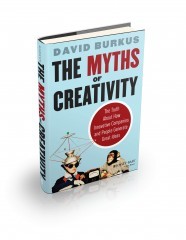We live and work in a world of complex problems, and few people would argue that we can solve those problems without a lot of creativity. Creativity is the seed of innovation and, in the business world, innovation is the seed of competitive advantage.
But as important as creativity is, most of us don’t really understand how it works and how to enhance our own creative thinking. Instead, we tell and retell a series of myths, faulty beliefs that serve as our best guess for how creativity works. But the implications of 50 years of research into creativity are re-writing many of those myths. The results might strike us as odd, but they are effective.
Creativity isn’t a vague and mysterious phenomenon. It’s a process that can be learned and developed. We all have the potential to enhance our creativity. We just need to learn the process.
Here are three counterintuitive tips that will enhance your own creativity:
1. Set More Constraints When we think of creative people, we think of them as wild and unrestrained. The truth is that most creative people would be at a loss without a certain level of constraints. Constraints create boundaries that actually help us understand the problem we face and evaluate possible solutions.
Research on individual creativity implies that we can actually open our minds to more creative ideas and better connect unrelated thoughts after we experience constraints. That’s why companies like 37Signals regularly build constraints into their work by limiting the number of people on a project or the number of features a software product can have. While it can feel frustrating in the moment, the result is a vastly better end product. If you’re stuck, trying setting more constraints and see if it helps you better understand your situation.
2. Start a Fight If you look at the offices of the most innovative companies, they seem fun loving and friendly. There are pool tables, free food, and a casual atmosphere. But if you look at their creative process, you find a lot more fighting than fun. Structured, task-oriented conflict is a signal that new ideas are being submitted and tested. A lack of conflict can suggest that people are self-censoring their ideas, or worse not generating any new ideas at all.
Research even supports the idea that adding task-focused conflict into a brainstorming session can actually increase the ideas generated. Film animation studio Pixar schedules regular meetings for the sole purpose of criticizing a film-in-progress. Directors put their project on full display and invite criticism and conflict over what could be done better. It may feel like a fight but it’s also what allows Pixar to churn out blockbuster after blockbuster. If you’re project needs a creative boost, trying inviting in a team to debate the work and build off their constructive criticism.
3. Copy While we rarely acknowledge it, many of the most creative works in history are actually the result of coping and combing various pre-existing works. In fact, most breakthrough creative works are the result of copying and modifying existing works. Microsoft and Apple both borrowed the design of Xerox’s Alto to build their personal computers. Van Gogh copied over 30 different paintings of prior masters to refine his own technique. George Lucas took the theme of Joseph Campbell’s “monomyth” and blended it with concepts and visuals from Akira Kurosawa films and Flash Gordon serials to create the blockbuster Star Wars series.
Research suggests that individuals whose brains make connections between various thoughts score higher on creativity tests. If you’re at a loss for new ideas, try to copy and combine successful ideas. You might just stumble into a breakthrough.
David Burkus is the author of The Myths of Creativity: The Truth About How Innovative Companies and People Generate Great Ideas. He is also founder of LDRLB and assistant professor of management at Oral Roberts University. You can find him on Twitter, Facebook, or at www.davidburkus.com.
Note from Jesse: This week celebrates the launch of David Burkus’s outstanding new book, The Myths of Creativity. A well-researched, easy to read and actionable book that debunks many of our commonly held notions of where creativity comes from and that shows us how to harness the power of creativity to free up the potential of our organizations and ourselves.















Great thoughts in this post. I especially like your point about most breakthrough creative works being the result of copying and modifying existing works. I’ve always privately thought this was the case so thanks for reinforcing by adding your own opinion + research results.
Many times I have felt prodded into a creative mindset after being stimulated by an idea generated by others. This is one of my favorite to initiate a line of thinking….
LaRae, me too. Creativity is a team sport and many times the ideas of others help move us along in our path. Thanks!
Nice points. There’s nothing like using the creative tension of constraints, fighting purposefully and copying to get people to the solutions – sometimes the most obvious ones – they didn’t expect to find.
Missed my opening point – being counterintuitive is hard, but these three elements allow breakthroughs.
Thanks Alan. Overall I think there’s a lot we purport to understand about creativity that doesn’t align with what research has shown, hence the idea of “Myths of Creativity” for the book. These three might be the most counterintuitive…all the more reason to give them a try.
I fought a lot during my tenure as a copywriter! I am happy to know that I am creative!
LOL! It’s certainly an indicator.
These thing make so much sense. I especially appreciate the advice about inviting criticism. If we are truly committed to great work we must have thick enough skin to hear the tough feedback.Congrats on the new book. Looking forward to reading it!
Thanks Susan. It’s a hard thing to receive criticism, but it makes us better. It’s all in the service of having a growth mindset and understanding failure and criticism are never permanent.
Excellent article. I love the fact that ideas and innovation are born out of blood and soil. The idea that where there is no “fight” you find no idea generation is true in my context. Regards!
Sherrell, mine too. If the entire team agrees on an idea, then most of them are probably unnecessary.
Hi David
I totally agree with what you wrote, especially point two, creativity is a result of passion, and passionate people will fight. The difference is in how they look at the fight, instead of thinking about it as getting bashed, they look at it as a challenge to be better. It may sometimes hurt but if we allow ourselves to rest on our laurels we will end up becoming a has been.
Great advice for all.
Thanks so much Robert. Reframing conflict is a huge part of it.